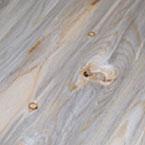Pont noted the similarity of the color of her jeans to the color of the pine. She and her husband Shane helped to form the Denim Pine Marketing Assn. to explore and promote value-added uses for the stained timber. "People buy washed oak, where the wood has been colored with blue or green, and use it for cabinetry and floors. Why wouldn't they want to use the real, naturally colored wood?" Pont says. The color comes naturally as the result of attack from the mountain pine beetle, which burrows under the bark of pine trees and introduces a fungus that turns the wood blue but. does not affect the quality of the timber in any other way. Before the marketing push, buyers called the wood "bug-kill" and largely avoided it. Now, denim pine is starting to get attention. "Denim pine can be used for anything normally made from pine, only these items will be blue-gray," says Pont. Pont is very excited about the progress made so far with the newly named material. Association representatives attended the The Log Home show in January, and plan to attend other trade shows to showcase Denim Pine's uses. The association has also created a Web site at www.denimpine.ca. One of the first licensed users of the trademarked material is Lori Gunderson of Eagleye Log Homes. Gunderson uses the stained logs in her log homes. She says the wood is like any other pine, except the material is already dried before it is cut. Finding Opportunity from Destruction British Columbia Minister of Industry Allan Rock praises the association. "Out of the devastation the blue mountain pine beetle has brought to our forests, the resourcefulness of British Columbians has resulted in a huge international marketing opportunity." The association stresses that the wood is environmentally sound; the wood is colored before the tree dies naturally. In addition, various affected groups, including the Nak'azdli First Nations, the Industrial Wood and Allied Workers of Canada, the private sector and local government, are represented on the Denim Pine Marketing Assn.'s board of directors. Created from Lodgepoles Donald Culross Peattie, in his book A Natural History of Western Trees writes about lodgepole pines. "As you cross the Great Plains of Montana or Alberta and reach at last the foot of the Rockies, you see that the slopes are swathed almost to their bases in a great zone of even-aged pines." Peattie writes the live lodgepole pines have yellow-green foliage, darker than the aspens that grow around them. "Frequently, though, hundreds of acres will be crowded with dead yet still standing lodgepoles, killed by fire or the far more insidious beetle." Peattie writes westerners sometimes refer to the sight as "ghost forests." Peattie explains that fire may devastate the lodgepole forests, but the trees have an unusual phoenix quality because of their uniquely packaged seeds, which are protected by a heavy coat of stiff resin. The resin melts in a fire and the seeds are released. Sometimes as many as 100,000 seedling trees grow in the space of an acre of burned timberland. Species closely related to Pinus contorta include Western white pine (Pinus monticoloa) and Canadian red pine (Pinus resinosa).
|






Have something to say? Share your thoughts with us in the comments below.